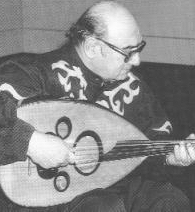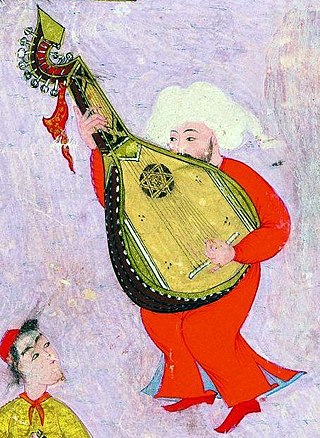
The oud is a Middle Eastern short-neck lute-type, pear-shaped, fretless stringed instrument, usually with 11 strings grouped in six courses, but some models have five or seven courses, with 10 or 13 strings respectively.

The music of Iraq or Iraqi music,, also known as the music of Mesopotamia, encompasses the music of a number of ethnic groups and musical genres. Ethnically, it includes Mesopotamian Arabic, Assyrian, Kurdish and the music of Turkmen, among others. Apart from the traditional music of these peoples, Iraqi music includes contemporary music styles such as pop, rock, soul and urban contemporary.
Arabic music is the music of the Arab world with all its diverse music styles and genres. Arabic countries have many rich and varied styles of music and also many linguistic dialects, with each country and region having their own traditional music.

The qanun, kanun, ganoun or kanoon is an Arabic string instrument played either solo, or more often as part of an ensemble, in much of the Arab East, and Arab Maghreb region of North Africa, later it reached West Africa, Central Asia due to Arab migration. It was also common in ancient Armenia, and Greece. The name derives ultimately from Ancient Greek: κανών kanōn, meaning "rule, law, norm, principle". The qanun traces one of its origins to a stringed Assyrian instrument from the Old Assyrian Empire, specifically from the nineteenth century BC in Mesopotamia. This instrument came inscribed on a box of elephant ivory found in the old Assyrian capital Nimrud. The instrument is a type of large zither with a thin trapezoidal soundboard that is famous for its unique melodramatic sound.

The goblet drum is a single-head membranophone with a goblet-shaped body. It is most commonly used in the traditional music of Egypt, where it is considered the national symbol of Egyptian Shaabi Music. The instrument is also featured in traditional music from West Asia, North Africa, South Asia, and Eastern Europe. The African djembe is also a goblet membranophone. This article focuses on the Middle Eastern and North African goblet drum.
The music of Lebanon has a long history. Beirut, the capital city of Lebanon, has long been known, especially in a period immediately following World War II, for its art and intellectualism. Several singers emerged in this period, among the most famous Fairuz, Sabah, Wadih El Safi, Nasri Shamseddine, Melhem Barakat, Majida El Roumi, Ahmad Kaabour, Marcel Khalife, and Ziad Rahbani, who—in addition to being an engaged singer-songwriter and music composer—was also a popular playwright. Lydia Canaan was hailed by the media as the first rock star of the Middle East.
Regarding the music of Syria, there are certain musical traditions and practices that have been present in Syria longer than others. There have been musical influences introduced into Syria through multiple eras of conquest and influences from surrounding cultures in modern-day Syria. Lying near Egypt and Israel, and connected to southern Europe by the Mediterranean, Syria became host to many distinct cultural musics through trade and route. The music present in Syria is related greatly to poetry, influenced greatly by the Bedouin nomadic tribes, the maqam system in Arabic classical music, as well as influenced greatly by the geopolitical movement and conflict in the Middle East. Syrian music generally has a singer who is accompanied by three or four instruments. The texture is usually thin but can become denser depending on the use of each instrument. Music is tightly linked to poetry in Syria.

Rabih Abou-Khalil is an oud player and composer born in Lebanon, who combines elements of Arabic music with jazz, classical music, and other styles. He grew up in Beirut and moved to Munich, Germany, during the Lebanese Civil War in 1978.

The culture of Lebanon and the Lebanese people emerged from various civilizations over thousands of years. It was home to the Phoenicians and was subsequently conquered and occupied by the Assyrians, the Greeks, the Romans, the Persians, the Arabs, the Crusaders, the Ottoman Turks and the French. This variety is reflected in Lebanon's diverse population, composed of different religious groups, and features in the country's festivals, literature, artifacts, cuisine and architecture of Lebanon. Tourism in Lebanon is popular with periods of interruption during conflict.

Islamic music may refer to religious music, as performed in Islamic public services or private devotions, or more generally to musical traditions of the Muslim world. The heartland of Islam is the Middle East, North Africa, the Horn of Africa, Balkans, and West Africa, Iran, Central Asia, and South Asia. Due to Islam being a multi-ethnic religion, the musical expression of its adherents is vastly diverse. Indigenous traditions of various part have influenced the musical styles popular among Muslims today. The word "music" in Arabic, the language of Islam, is defined more narrowly than in English or some other languages, and "its concept" was at least originally "reserved for secular art music; separate names and concepts belonged to folk songs and to religious chants".

Munir Bashir, was an Iraqi Assyrian musician and one of the most famous musicians in the Middle East during the 20th century and was considered to be one of the supreme masters of the Arab maqamat scale system.

The Shahrud was a short-necked lute, illustrated in the Surname-i Hümayun, resembling an oud or barbat, but being much larger. The larger size gave the instrument added resonance and a deeper (bass) range, like the modern mandobass, mandolone or Algerian mandole.
In Arabic Music, the mawwāl is a traditional and popular Arabic genre of vocal music that is very slow in beat and sentimental in nature, and is characterised by prolonging vowel syllables, emotional vocals, and is usually presented before the actual song begins. The singer performing a mawwal would usually lament and long for something, such as a past lover, a departed family member or a place, in a wailing manner.

Arabic pop music or Arab pop music is a subgenre of pop music and Arabic music.

Omar Bashir is an Iraqi-Hungarian musician. His father, Munir Bashir, was considered to be the supreme master of the Arab maqamat scale system.
In traditional Arabic music, maqam is the system of melodic modes, which is mainly melodic. The word maqam in Arabic means place, location or position. The Arabic maqam is a melody type. It is "a technique of improvisation" that defines the pitches, patterns, and development of a piece of music and is "unique to Arabian art music". There are 72 heptatonic tone rows or scales of maqamat. These are constructed from augmented, major, neutral, and minor seconds. Each maqam is built on a scale, and carries a tradition that defines its habitual phrases, important notes, melodic development and modulation. Both compositions and improvisations in traditional Arabic music are based on the maqam system. Maqamat can be realized with either vocal or instrumental music, and do not include a rhythmic component.

Farid and Rami Chehade, who perform professionally as the Chehade Brothers, are Palestinian–Lebanese musicians and singers.
Assyrian folk/pop music, also known as Assyrian folk-pop, is the musical style of the Assyrian people derived from traditional music that includes a broad range of stylistic varieties, which would also encompass fusions of Western genres such as pop, electronic, Latin, jazz and/or classical music, with a melodic basis of Assyrian folk.

Lydia Canaan is a Lebanese singer-songwriter, poet, humanitarian activist, and diplomat. She is noted for her four-octave vocal range, unique vocal stylings, songwriting, and for being the first Lebanese artist in music history to achieve global success. Widely regarded as the first "rock star" of the Middle East, she is cataloged in the Rock and Roll Hall of Fame and Museum's Library and Archives.
The Brothers of the Baladi is a World music band based in Portland, Oregon, USA, that plays both traditional Middle Eastern music, and also combines traditional Middle Eastern and western sounds and instruments for a unique Worldbeat sound. Band leader/percussionist/vocalist Michael Beach provides lyrics in Arabic, Turkish, Persian, French, Spanish, Kurdish, Armenian and English, and the band features many traditional Middle Eastern instruments including oud, saz, mizmar, midjwiz, arghool, doumbek, riq, def, tar, bendir and davul.
















